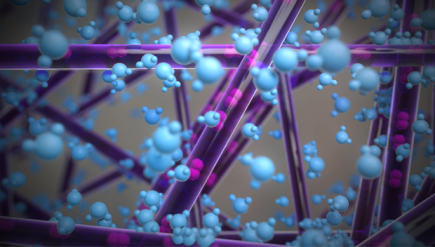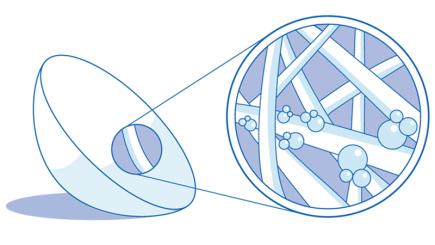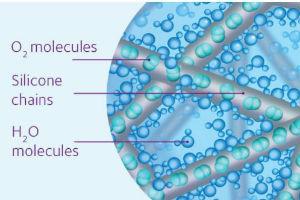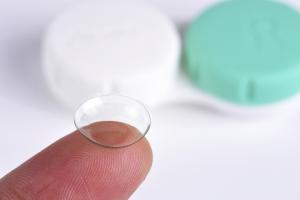
Silicone hydrogel (SiHy) contact lenses were first introduced over 20 years ago, and eye care professionals (ECPs) continue to routinely prescribe them for their extended, continuous, and daily wear patients due to the lenses’ many ocular health benefits.1,17†
Despite their advances, SiHy lenses faced some challenges along the way, including finding the right balance between moisture content, oxygen transmissibility, and modulus, in addition to establishing the optimum comfort level for wearers. CooperVision created a solution for these issues by developing Aquaform® Technology, which is found in its Biofinity® and MyDay® contact lens families. Aquaform® Technology promotes a healthy wearing experience and incredible comfort due to its unique design which allows water to be held throughout each lens, from its core to its surface, helping to keep the lens moist all-day long.2
“The thing that I love about Aquaform® Technology is the fact that not only does the lens stay wet all daylong, but because of its long silicone chains, less silicone is used in the lens,” says Dr. Rajiv Patel, OD, FAAO, of Vancouver Vision Clinic. “As a result, the lens has a really soft modulus. That allows the lens to be really comfortable while still allowing for the great oxygen transmission that you expect with a SiHy. Between the attributes of the lens and the benefits that our patients have from a comfort standpoint, it has become the go-to material science in our practice.”
Maximized Comfort Without Additives, Wetting Agents, or Surface Treatments
Since 1999, three generations of SiHy lenses have been introduced.3 The Aquaform® Technology found in both the Biofinity® and MyDay® contact lens families represents the third generation of SiHys.3 These lenses utilize a unique, long-chain siloxane macromer in combination with other components to produce a highly breathable and wettable, low modulus lens.2,4,5
The hydrophilic arms on Aquaform® Technology’s silicone chain network attract and anchor water molecules throughout the lens matrix, efficiently delivering oxygen while retaining moisture for core to surface wettability without the need for surface coatings or wetting agents.2
“Lenses with Aquaform® Technology help retain moisture and help retain water,” explains Dr. Mike Shaheen, OD, of Hills and Dales Vision in Canton, Ohio. “This technology gives us extremely comfortable lens wear all day long. And the breathability to the front of the eye is a huge thing. We want this oxygen getting to the front of the eye. It’s not just that it’s a silicone hydrogel lens. It’s technology that gives you hydration from the core to the surface. There’s no surface coating. There are no extra agents added to it to try to help with the wettability of the lens.”
Lens Comfort Is Key to Wearing Success
We know that dryness and discomfort are common reasons for dropout.2,6,7,8 In fact, one study that examined contact lens retention rates found 36% of new wearers cited application and removal discomfort as their main reason for discontinuing lens wear.9
Additionally, the seminal Tear Film & Ocular Surface Society International Workshop on Contact Lens Discomfort reported that contact lens discomfort was a substantial and burdensome problem experienced frequently by contact lens wearers.10 Further, many wearers experienced contact lens discomfort to such a severity, they felt compelled to change their wearing habits.10 These findings underscore why material choice is key in preventing dropout.
The Role of The Lens Modulus
The modulus of a soft contact lens is extremely important to the lens fit and patient comfort. It can affect optical performance, fit, on-eye movement, wettability, physiological impact, and overall comfort.11 The lens modulus also impacts its resistance to damage during lens handling.
“Aquaform® Technology provides an optimum modulus to the lens, which makes it easier for patients to insert, remove, and handle the lenses, and that makes it easier for my staff to train them”, says Sahil Dosaj, OD, of Miller Optometry in Yucaipa, CA. “That reduces my chair-time, and it increases the efficiency of my office.”
When compared to previous generations, a lower modulus lens, like Biofinity® for monthly wearers or MyDay® for daily disposable wearers, is likely to decrease the incidence of mechanically induced events.6 Additionally, Aquaform® Technology results in a softer, more flexible lens.
The Science Behind Aquaform® Technology

Lenses with Aquaform® Technology, coupled with optimum lens design, are hydrated to twice their weight in water.2 The technology provides the right balance of moisture, oxygen transmissibility, and modulus due to a unique integration of structures throughout the contact lens material.2 Aquaform® Technology is comprised of a proprietary network of long and short silicone chains, interlinked purposefully to provide excellent oxygen transmission while maintaining an optimal lens modulus.2
The unique science behind Aquaform® Technology delivers the comfort, wettability, breathability, and softness that contact lens wearers and their ECPs require for a healthy† and comfortable lens wearing experience over a lifetime of wear.12,13,14 Just consider, lenses with Aquaform® Technology are currently worn by over 24 million patients who experience not only clear vision but incredible comfort.15
“24 million sounds like such a big number, but individually, when we look at what we’re doing in our offices, you have those real-world experiences from that 24 million happening in your own place every day,” Dr. Shaheen says.
Biofinity® And MyDay® Contact Lens Families
Aquaform® Technology was first available in the Biofinity® family of lenses. Biofinity® lenses (comfilcon A) are a monthly replacement lens available in a large range of parameters in a full family that includes sphere, toric, multifocal, and toric multifocal options. Biofinity® is the most prescribed monthly replacement contact lens brand on the market.15,16 Biofinity Energys® contact lenses are designed specifically for our modern lifestyle. The lens combines the material benefits of Aquaform® Technology with DigitalBoost™ optics to help with eye dryness and tiredness associated with digital eye strain.
Aquaform® Technology was later optimized for the 1-day wearing experience with MyDay® (stenfilcon A) lenses. MyDay® is a full family of daily disposable lenses made of CooperVision’s softest lens material with a high-water content (54%). The lenses are available in a wide range of parameters for sphere, toric and multifocal wearers. MyDay Energys® is the newest addition to the MyDay® family.
Final Thoughts
ECPs can confidently prescribe lenses with Aquaform® Technology, knowing that their patients wearing Biofinity® and MyDay® lenses will experience incredible comfort regardless of their prescription need. When considering material choice for their patients, ECPs should remember that CooperVision lenses with Aquaform® Technology offer the unique combination of wettability, breathability, and optimal modulus to support their patients’ needs throughout a lifetime of contact lens wear.








